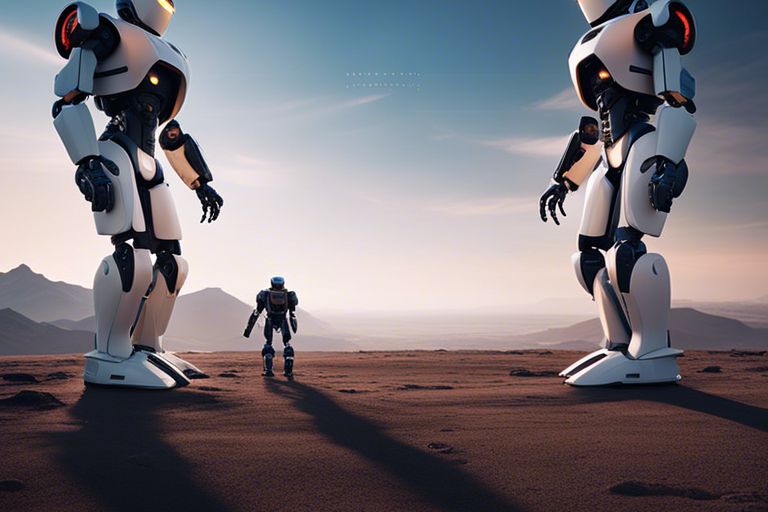The Future of AI-Powered Robotics – Advancements and Challenge

It’s impossible to deny the rapid advancements that artificial intelligence (AI) has brought to the field of robotics in recent years. From self-driving cars to automated industrial processes, the integration of AI has revolutionized the capabilities of robots. However, along with these exciting advancements come significant challenges that must be addressed for the future of AI-powered robotics. In this blog post, we will explore the potential benefits of AI-powered robotics, as well as the ethical dilemmas, security concerns, and economic implications that accompany this transformative technology.
Technological Advancements in AI Robotics
Breakthroughs in Machine Learning and AI
To keep up with the growing demands of complex tasks in various industries, robotics has made significant progress in machine learning and AI. These breakthroughs have enabled robots to analyze data, learn from it, and make decisions autonomously, enhancing efficiency and productivity in different applications.
Robotics Mobility and Dexterity Enhancements
To address the limitations of traditional robotics in navigating complex environments and performing intricate tasks, robotics has focused on enhancing mobility and dexterity. These advancements have led to robots with the ability to move more fluidly, manipulate objects with greater precision, and adapt to dynamic surroundings.
Breakthroughs in robotics mobility include the development of agile robotic systems that can operate in confined spaces or hazardous environments with ease. Additionally, enhancements in dexterity enable robots to handle delicate objects with precision, opening up opportunities for automation in industries such as healthcare and manufacturing.
Integration and Applications
AI Robots in Industry and Manufacturing
One of the most significant applications of AI-powered robotics is in industry and manufacturing. These robots are revolutionizing production lines by increasing efficiency, precision, and flexibility. They can handle repetitive tasks with accuracy and speed while also adapting to changing production demands. AI robots are significantly reducing the margin of error and improving safety in hazardous working environments.
Expanding Frontiers: Healthcare, Services, and Beyond
Beyond industry, AI-powered robots are making a mark in healthcare, services, and beyond. Robots are now assisting surgeons in complex operations, providing companionship to the elderly, and even delivering room service in hotels. The potential applications are limitless, with robots taking on tasks that were previously unimaginable.
Applications: The integration of AI in robotics opens up a world of possibilities for various sectors. From precision surgeries in healthcare to personalized services in hospitality, AI robots are reshaping the future of work and services. However, as with any technology, there are concerns about data privacy, job displacement, and ethical considerations that need to be carefully addressed.

Challenges Facing AI-Powered Robotics
Ethical and Social Implications
Many ethical and social implications arise with the integration of AI in robotics. With the ability of robots to autonomously make decisions, concerns about accountability, bias, and privacy emerge. There are also fears surrounding the impact of AI-powered robotics on job displacement, inequality, and even potential misuse for malicious purposes.
Technical and Security Concerns
Robotics presents various technical and security concerns that need to be addressed. The vulnerability of AI systems to hacking and cyber attacks pose serious risks, especially if robots are used in critical infrastructures or sensitive environments.
The rapid advancements in AI and robotics also raise worries about the potential for systems to malfunction or behave unpredictably, leading to accidents or errors. Ensuring the reliability, robustness, and safety of AI-powered robots is crucial to prevent catastrophic consequences.
Directions for Future Research and Development
Sustainability and Environmental Considerations
The ongoing development of AI-powered robotics presents a unique opportunity to address sustainability and environmental concerns. The integration of renewable energy sources and energy-efficient designs can significantly reduce the carbon footprint of robotics systems. Advancements in recyclable materials and end-of-life disposal strategies are crucial for minimizing environmental impact.
Enhancing Human-Robot Collaboration
Collaboration between humans and robots is a key focus for future research and development in the field of AI-powered robotics. Collaboration can lead to increased productivity and safety in various industries. By developing intuitive interfaces and adaptive algorithms, we can further enhance human-robot interaction and seamless cooperation in shared workspaces.
To foster effective collaboration between humans and robots, it is vital to design robots capable of understanding and responding to human behavior in real time. Shared autonomy where robots and humans can both contribute to task completion is a promising direction for enhancing productivity and efficiency in collaborative settings.
To wrap up
So, the future of AI-powered robotics holds great advancements and challenges as technology continues to rapidly evolve. With the potential to revolutionize industries, improve productivity, and enhance our daily lives, AI-powered robots are set to become increasingly prominent in various sectors. However, as we embrace these advancements, we must also address challenges such as ethical considerations, job displacement, and the need for regulation to ensure responsible development and deployment of AI technology. Overall, the future of AI-powered robotics is promising, but it requires careful navigation to maximize its benefits while mitigating potential risks.






